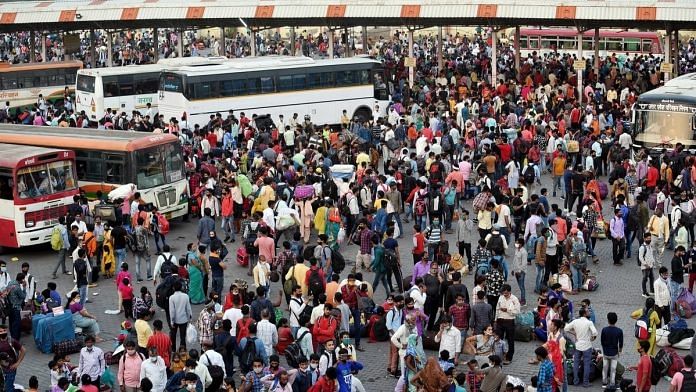New Delhi: The Delhi government has refrained from implementing stricter restrictions in the light of the current Covid-19 surge, fearing it could lead to a large number of migrants leaving the city, as during the first two lockdowns in 2020 and 2021, senior officials in the Delhi Disaster Management Authority (DDMA) have told ThePrint.
According to the officials, fear of mass migration — which can have health, economic and political repercussions — is the primary factor that is forcing the government to tread with caution when it comes to imposing restrictions.
Delhi Tuesday recorded 5,481 new Covid-19 cases and a positivity rate of 8.37 per cent — up from Monday’s 6.5 per cent, the government’s health bulletin said.
The DDMA held a meeting Tuesday to discuss the possibilities of more curbs, including whether to declare a “red alert”, which implies a full lockdown under the government’s own graded action plan for Covid-19, in the light of a high positivity rate, according to government documents ThePrint has accessed.
But after Tuesday’s meeting, Deputy Chief Minister Manish Sisodia announced only a few restrictions — such as a weekend curfew and a work-from-home plan for government offices not engaged in essential services — over and above restrictions implemented since 27 December.
The existing restrictions include complete suspension of schools, colleges and other educational institutions, closure of gyms and spas, a plan that allows shops in markets and malls to open only on alternate days, a cap on the number of attendees at marriages and funerals, and a complete ban on all forms of gatherings.
The DDMA took a similar decision in its previous meeting on 31 December too, when Delhi had recorded a positivity rate of over 1 per cent for two consecutive days and qualified for an ‘amber alert’ — lower than red in terms of strictness, but higher than the ‘yellow alert’ that was implemented on 27 December. The government then had stuck with the restrictions under the yellow alert.
The government’s graded action plan that was notified last year has four alert levels for implementing different sets of curbs — yellow, amber, orange and red. Yellow is the least strict and red the most.
The set of restrictions currently in place in Delhi is a mix of different sets of restrictions from the plan, instead of the straight implementation any one particular colour-coded alert, explained a DDMA official who did not wish to be named.
The DDMA is chaired by Lieutenant Governor Anil Baijal, who is appointed by the BJP-led Union government. Its vice chairperson is Delhi Chief Minister Arvind Kejriwal.
Also read: About 5,500 new Covid cases reported in Delhi; weekend curfew not lockdown: Jain
Government treading with caution
Delhi’s revenue minister Kailash Gahlot, who is also a DDMA member, told ThePrint: “During the first wave, we witnessed reverse migration of large numbers of people from Delhi to their home states. In the second, we controlled that to a large extent. This time, we will take all possible steps to ensure that it does not happen at all.”
Large numbers of migrant labourers left the city in lockdowns imposed in 2020 and 2021. While the government did not keep records of migration in 2020, more than 1.33 million people left Delhi in the first month of the second lockdown in April 2021, according to government officials.
Delhi has a population of around 20 million of which — Census 2011 data and Delhi government estimates suggest — around 43 per cent are migrants from other states, mostly Uttar Pradesh, Bihar, Haryana and Uttarakhand.
“At Tuesday’s meeting, it emerged that a full lockdown could lead to severe panic among migrants and lead to large numbers of them leaving the city. We can’t take chances. It can lead to further spread of the disease and the economic implications are massive too. So, we have to form a strategy accordingly,” said a senior DDMA official who did not wish to be identified.
A government official said on the condition of anonymity that imposing lockdowns in haste and forcing people to migrate can irk them — and that can have political consequences ahead of assembly polls in five states.
(Edited by Saikat Niyogi)
Also read: Delhi could have 40,000-1 lakh Covid cases daily in few weeks, disaster management meeting told



